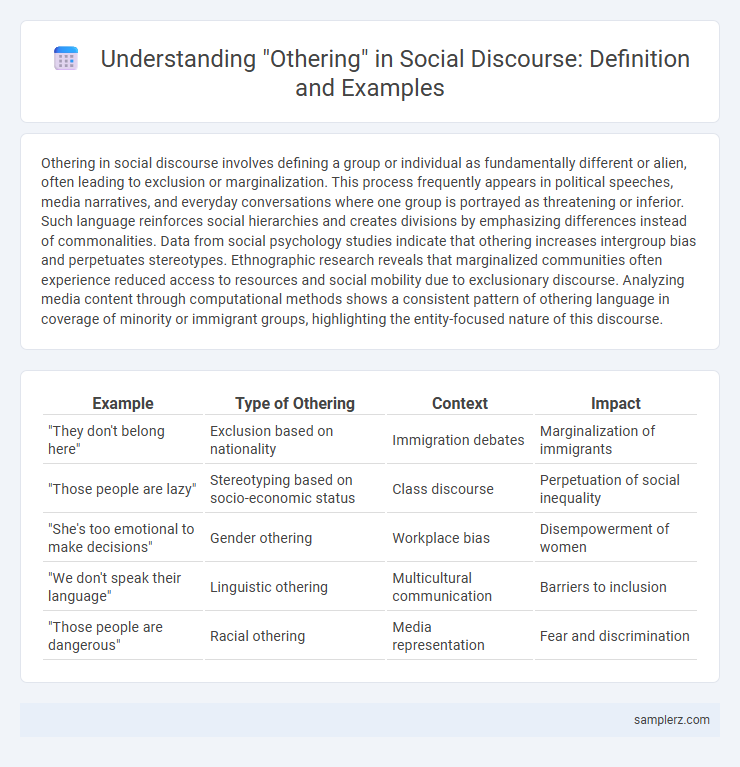Othering in social discourse involves defining a group or individual as fundamentally different or alien, often leading to exclusion or marginalization. This process frequently appears in political speeches, media narratives, and everyday conversations where one group is portrayed as threatening or inferior. Such language reinforces social hierarchies and creates divisions by emphasizing differences instead of commonalities. Data from social psychology studies indicate that othering increases intergroup bias and perpetuates stereotypes. Ethnographic research reveals that marginalized communities often experience reduced access to resources and social mobility due to exclusionary discourse. Analyzing media content through computational methods shows a consistent pattern of othering language in coverage of minority or immigrant groups, highlighting the entity-focused nature of this discourse.
Table of Comparison
| Example | Type of Othering | Context | Impact |
|---|---|---|---|
| "They don't belong here" | Exclusion based on nationality | Immigration debates | Marginalization of immigrants |
| "Those people are lazy" | Stereotyping based on socio-economic status | Class discourse | Perpetuation of social inequality |
| "She's too emotional to make decisions" | Gender othering | Workplace bias | Disempowerment of women |
| "We don't speak their language" | Linguistic othering | Multicultural communication | Barriers to inclusion |
| "Those people are dangerous" | Racial othering | Media representation | Fear and discrimination |
Defining Othering in Social Discourse
Othering in social discourse involves categorizing individuals or groups as fundamentally different, often leading to exclusion or marginalization based on perceived identity markers such as race, ethnicity, or socioeconomic status. This process reinforces in-group and out-group distinctions, perpetuating stereotypes and social hierarchies. By defining others as "not us," othering shapes social narratives and power dynamics, influencing interactions and societal norms.
Historical Examples of Othering Narratives
Historical examples of othering narratives often manifest in colonial-era texts portraying indigenous peoples as uncivilized or savage, thereby justifying conquest and exploitation. Religious propaganda during the Crusades depicted non-Christians as infidels or heathens, promoting division and conflict. Similarly, racial segregation laws in the Jim Crow era were supported by narratives that dehumanized African Americans to sustain systemic discrimination.
Language Patterns that Perpetuate Othering
Language patterns that perpetuate othering often include the use of pronouns like "they" versus "us," creating a clear division between groups and reinforcing exclusion. Stereotyping through generalized statements about cultural or social groups amplifies distance and reduces individual identity to simplistic traits. These discourse practices embed power dynamics and social hierarchies, making the marginalized group linguistically invisible or alien within public conversations.
Media Representation and the Construction of “Outsiders”
Media representation often constructs "outsiders" by perpetuating stereotypes and marginalizing specific groups through selective framing and language. News outlets frequently emphasize cultural or ethnic differences, which reinforces social divides and influences public perception negatively. This othering in discourse marginalizes communities, shaping social hierarchies and limiting opportunities for inclusivity in society.
Political Rhetoric: Us vs. Them in Public Speech
Political rhetoric often employs "us vs. them" narratives to create social divisions by framing opponents as threats to collective identity. Terms such as "patriots" versus "traitors" amplify polarization and reinforce in-group loyalty while marginalizing dissenting voices. This strategic othering shapes public opinion by simplifying complex issues into binary contrasts, undermining inclusive discourse.
Stereotypes and Labeling in Everyday Conversation
Stereotypes and labeling in everyday conversation create social divisions by assigning fixed characteristics to individuals based on group identity, often reinforcing negative biases. These practices other people by reducing their complex identities to simplistic, generalized traits, which can marginalize and exclude them from broader social interactions. Such linguistic behaviors perpetuate misunderstanding and hinder social cohesion by embedding prejudice within ordinary dialogue.
Exclusion through Jokes and Humor
Exclusion through jokes and humor often manifests in social discourse by targeting specific groups with stereotypes or derogatory remarks, reinforcing social boundaries and marginalization. These forms of humor rely on shared prejudices, effectively alienating those who are the subject of the joke while fostering in-group cohesion. Research in sociolinguistics highlights how such exclusionary humor perpetuates discrimination and maintains power imbalances within communities.
Online Communities and Digital Othering
Online communities often engage in digital othering by creating in-group and out-group distinctions based on identity markers such as race, gender, or political beliefs. This form of othering manifests through exclusionary language, stereotyping, and the amplification of negative narratives about marginalized groups. Digital platforms enable rapid dissemination of such discourse, reinforcing social divides and perpetuating online harassment against those deemed as outsiders.
Othering in Educational Materials and Curriculum
Educational materials and curriculum often perpetuate othering by marginalizing non-dominant cultures and perspectives, reinforcing stereotypes and exclusion. Textbooks may present history and literature primarily from a Eurocentric viewpoint, neglecting the contributions and experiences of indigenous peoples, people of color, and other minority groups. This biased representation shapes students' worldviews, limiting empathy and understanding across diverse social identities.
Strategies for Challenging Othering in Social Interaction
Challenging othering in social interaction involves actively using inclusive language that validates diverse identities and experiences. Engaging in perspective-taking encourages empathy and reduces stereotypes by recognizing the shared humanity behind perceived differences. Promoting dialogue that centers marginalized voices helps dismantle power imbalances and fosters equitable communication.

example of othering in discourse Infographic
 samplerz.com
samplerz.com